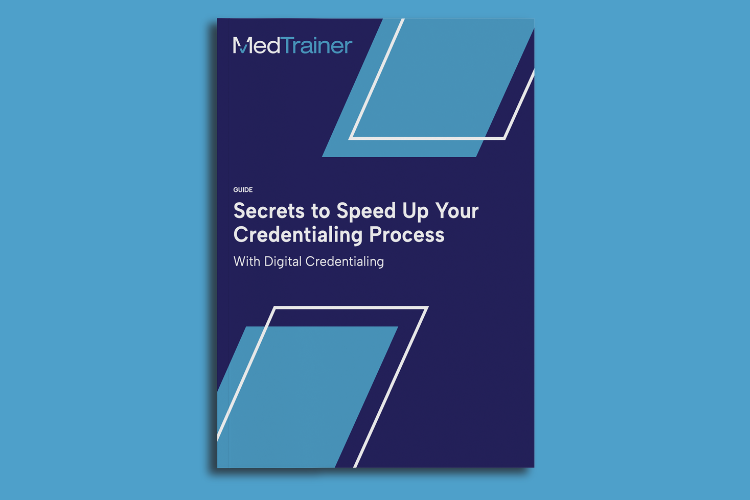There’s a lot of confusion surrounding the difference between credentialing and privileging. Credentialing is like asking your chef to show you his culinary school diploma; privileging is asking him to julienne a carrot. Both are important to make sure you have a qualified and skilled person preparing your food. Similarly, healthcare organizations want to make sure they have qualified and skilled medical professionals treating their patients.
Credentialing vs. Privileging: A Quick Overview
Before they put people to work, healthcare organizations are responsible for verifying the qualifications and capabilities of physicians and dentists. Credentialing and privileging for nurses depends on each state’s licensing requirements. Let’s take a look at the credentialing meaning.
What is credentialing?
Credentialing ensures that providers have the proper license and documentation to provide treatment. Through this process, they’re charged with safeguarding the health and well-being of patients — as well as protecting the facility from potential liabilities.
What is privileging?
Privileging requires the provider to prove they are capable of the specific skills they intend to perform. Privileging ensures that individuals act within the scope of their practice and provide competent patient care in line with their role at the facility.
Together, credentialing and privileging create assurances that any healthcare provider hired to do a job is both well-qualified to do what’s expected of them and capable of executing to required standards.
Credentialing Basics: Requirements & Application Process
Credentialing involves verifying a healthcare provider’s qualifications and background to ensure that they meet the standards for patient care. The goal is to ensure providers have the education, training, and experience to provide safe and effective care. The following steps are involved in credentialing:
- Application: The provider applies to the organization, providing information on their education, training, and experience.
- Verification: The organization verifies the provider’s credentials by contacting their educational institutions, licensing boards, and other relevant organizations.
- Review: The organization reviews the provider’s application and verifies that they meet education, training, and experience standards.
- Approval: The organization approves the provider’s application if it meets its standards. This is the first step towards practicing.
- Monitoring: The organization continuously monitors the provider’s credentials to remain current year over year, or against changing standards.
Credentialing is an essential part of the healthcare industry. It ensures a provider continually has the education and skills to perform in their role and protects patients from discrepancies in care, to safeguard their health and well-being.
The verification process for credentialing can be long and laborious. It’s often easier to see the steps when all information and documents are in one place with visibility.
Get secrets to speed up your credentialing process.
How to Navigate the Privileging Process
Privileging requirements and steps can differ depending on the healthcare setting the provider works in. Yet, in all cases, privileging records ensures each healthcare provider is capable of delivering a superior standard of care based on their job requirements.
The specific steps for awarding privileges to a provider in a facility can vary depending on the organization’s policies and procedures. Here are some common steps typically involved in the privileging process:
- Determine the needed privileges: The facility will first decide what specific privileges are optimal for the provider based on their specialty or scope of practice.
- The provider applies: The application should include details of the provider’s education, training, experience, and any relevant certifications or licenses.
- Verification of credentials: The facility will verify the provider’s credentials, education, training, and licensure. This may involve contacting educational institutions, previous employers, and licensing boards. Accrediting bodies like The Joint Commission require Primary Source Verification, which can be a lengthy process in itself.
- Peer review: This step may involve input from other providers, staff, or patients to assess the provider’s clinical competence and expertise in the requested privileges.
- Approval of privileges: Based on the verification of credentials and the peer review results, the facility will approve the privileges the provider can perform.
- Monitoring and re-evaluation: The facility will monitor the provider’s performance and conduct ongoing evaluations to ensure they maintain the necessary skills and competence to continue performing the approved privileges.
It’s important to note that the privileging process is ongoing. The provider’s privileges may be adjusted or revoked if they fail to maintain the necessary skills and competence — or if their credentials are invalid.
Since the onus is on the provider to supply documentation and credentials, implementing a system to request information from providers can help hospitals with the privileging process.
Download a checklist to speed up your privileging process.
What to Include in Credentialing and Privileging Documentation
A provider will typically need to provide the following information and documentation:
- Educational history and transcripts
- Current medical license
- DEA registration
- Board certification (if applicable)
- Work history
- Evidence of continual malpractice coverage
- Personal immunization records
- Professional and personal references
- CAQH enrollment
- OIG/SAM Exclusion Check
It’s important to note that the specific requirements for applying may vary depending on the healthcare facility and the particular role of the provider, but as you can see, dozens of documents are required for each provider. In fact, paper can (literally) stack up and many times it is very difficult to get all documentation from a provider. Many healthcare organizations are turning to credentialing software that enables the to send an email to a provider with a link to securely upload all documents.
Recredentialing and Privileging Redetermination
Recredentialing is necessary as credentials typically expire in two-year increments. With this in mind, you should have a plan in place for tracking credentialing for all current healthcare professionals working at the facility. Using credentialing software with automated reminders months before expiration will help you avoid any reimbursement issues.
As with credentialing, privileging is also an ongoing process that requires the initial privileging of a provider and continued evaluation of their performance on the job. Processes should be implemented to provide real-world, objective evidence of the provider’s effectiveness in performing their defined duties.
Both credentialing and privileging are essential for maintaining compliance with local, state, federal, and third-party requirements, as well as tools to ensure your patients receive the best care your facility can provide.
Credentialing and Privileging: Different Processes, Similar Management
Both credentialing and privileging create additional work that can be frustrating — and often, time-consuming. It’s important for you to find a process, or workflow, that streamlines your tasks and ensures you don’t miss critical deadlines. If your process needs a boost, consider enterprise-grade credentialing software — or even managed credentialing services to remove all tasks from your plate. See if MedTrainer is a good fit.

